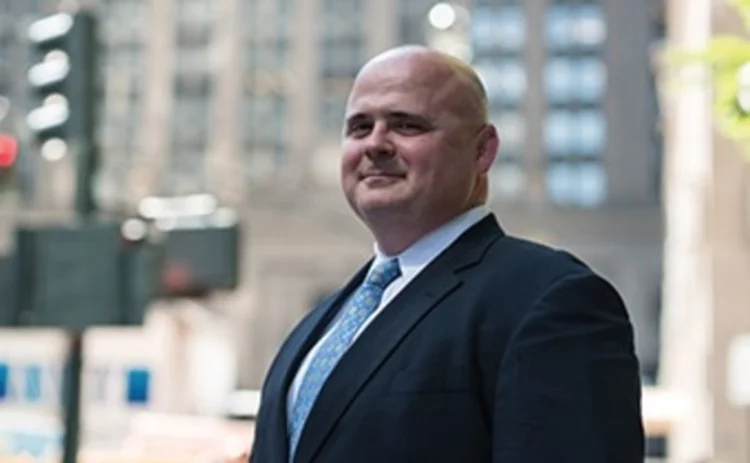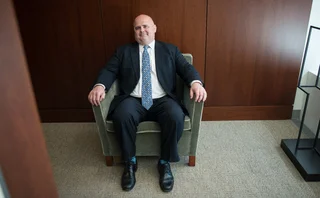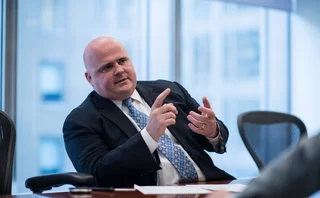JPMorgan Asset Management's Curt Engler: Building Bigger Better
As head of trading for JPMorgan Asset Management’s massive US equities desk, Curt Engler talks his firm's growing buy-side presence.

Among the buy side’s many outsized personalities, few genuinely command a room like Curt Engler.
Thoughtful and carefully spoken, Engler was a collegiate wrestler at the University of Notre Dame, and can be generously described as a “big dude.” Even his holidays fit the persona: He makes a regular hop over the Atlantic to Munich for the Starkbierzeit (literally, the ‘Strong Beer’ Time) festival held around the Bavarian capital every spring. As Engler’s a brewer in his own right, Oktoberfest doesn’t quite cut it.
Visiting at JPMorgan’s global headquarters at the northern foot of Park Avenue, Engler ponders how his past athletic success influences his current work. With a laugh, he claims he’s never given it a thought.
But heading up trading at a major investment manager—and few are larger than JPMorgan Asset Management’s (JPMAM’s) $1.7 trillion total under management, almost a trillion of which is institutional money—is a lot like stepping onto the mat. As any wrestling fan knows, the sport is as much about technique and quickness as it is about brute strength. It’s about being smart, about situational awareness and anticipating your adversary.
Similar battles are fought in the equities market every day—every second, in fact. The approximately $230 billion in assets under Engler’s care are massive; indeed, the firm’s US equities holdings eclipse many traditional asset managers’ entire trading books by themselves. These days, that makes JPMorgan a target, and JPMAM can be forgiven for throwing its weight around a little bit when microstructure issues arise. In some moments, there is no substitute for size.
“Projects have to be broken down into small deliverables—setting scope, being specific around requirements—and then you’re much more involved in the development cycle, with daily and weekly tracking and monitoring release cycles, rather than just saying, ‘I want the system to do this.’ It’s much more iterative now, and from my experience that’s the biggest difference, being that involved with that production cycle.”
Much of Engler’s role, though, is far more nuanced. His task is running a smart shop, with an eye toward capturing and measuring every last detail at every possible point in the process, from portfolio management styles to post-trade analytics.
And to this extent, he is a forerunner in the evolution of the historical and somewhat enigmatic “head of trading” position—one now actively engaged in the design and deployment of serious technology.

A Technologist in All But Name
After Notre Dame, Engler began his career by making the short trip to Chicago, supporting the quantitative trading desk at a boutique firm, Weiss, Peck and Greer, which was eventually sold to Robeco. Since then, he’s run desks at some of the largest fund managers in the country—managing indexes and enhanced indexes trading at Northern Trust, and later at BlackRock.
He made the jump to JPMorgan in 2010, running automated and quantitative strategies for equities. Five years later, with Engler now overseeing the entire US desk, the numbers are staggering: $1.8 billion notional traded every day in listed stocks across 6,000 and 8,000 orders, with 90 percent of those—representing around 60 percent of the notional—running through JP’s “quantitative sleeve,” to use the firm’s terminology.
As Engler puts it, his best move was learned early on: Follow the quants, and configure your electronic trading platforms to provide them with greater dexterity around the process—or as Engler puts it directly, “more control.”
“Implementing technology that encapsulates research and transaction-cost analysis (TCA), with the increasing influence that the buy side has in self-directing and scheduling trades, you become so much more involved,” he says. “Projects have to be broken down into small deliverables—setting scope, being specific around requirements—and then you’re much more involved in the development cycle, with daily and weekly tracking and monitoring release cycles, rather than just saying, ‘I want the system to do this.’ It’s much more iterative now, and from my experience that’s the biggest difference, being that involved with that production cycle.”
Upon arrival, JPMAM had multiple legacy systems whose functions needed to be integrated, so at first, Engler’s efforts were focused on architectural simplification. But the project blossomed into something bigger, lasting three years, and consequently changing the mix among the desk’s human personnel, one outcome of which was adding more quantitative resources.
“We really just had to rethink our whole order flow and trading process,” he explains. “As our assets have grown bigger, our orders have only gotten larger. And against the backdrop of the complex liquidity ecosystem we’re dealing with now, it was a necessity to both build more capacity into our funds and lower trading costs.”
Technical Intuition
The resulting platform at JPMAM touches on a pair of different but equally important areas. One of them, sourcing liquidity, is arduous and never-ending, but fairly conventional. The other is a newer art form: baking in portfolio managers’ behavior and patterns, and tying those back to execution strategies.
“We wanted to go one step further in co-developing an order flow router—the workhorse on the desk—and went deep in on scheduling trades based on cost and risk estimates, and then sourcing dark and lit liquidity once we have the schedule and fitting orders into the configuration,” Engler says. “The research on a millisecond level has greatly increased and driven performance there. Sourcing dark liquidity, getting transparency on order types allowed in those venues, constituents in the pool, and the tiering we could deal with in terms of interaction was part of that. But even sourcing lit liquidity and smart order routers, there’s still a bunch of flavors to account for. It’s about including that level of detail, destination by destination.”
A rules engine was also built into the order management system (OMS) incorporating managers’ characteristics to have orders flow where and when they’re best suited to be traded. The theory is straightforward: When you’re talking about hundreds of billions traded over a year, even 1 percent is serious money saved—or lost.
“You begin the process from a macro level by reviewing the portfolio manager to tune the trading strategies or the level of aggressiveness appropriately, and then collecting a lot of data on algo performance and router performance, again, with the view of shaving off a basis point here or there,” he says. “There was a huge effort to get that whole data infrastructure correct—every action on an order will have an effect on the database in the back; getting that right required a lot of work and proprietary analytics along with third-party verification. Generating new intellectual property, we wanted to control all of that.”

Balanced Outcomes
So, just what does success look like—particularly for a firm moving so much inventory that it can sometimes be hard to tease out what is cause and what is effect?
“In terms of questions and answers, the biggest thing from a cost perspective we’re managing is a distribution of outcomes,” Engler says. “And in order to have cost be normally distributed, no fat tail of just outliers, we want to make sure our behavior is symmetric. Knowing where we can be a liquidity provider and more patient, versus where we need to demand it, managing that distribution will lower the overall cost if we can balance that effectively. To that end, we use the platform to analyze several different cuts based on order size, participation rates, and other metrics. If we’re seeing too much post-trade price reversion, or leaving return on the table, that will point us in another direction toward being more aggressive.”
This may be the top-line goal, though the system was designed with context in mind as well—with two emphases standing out. First, the cost profile for each team depends greatly on individual investment processes, and therefore demands an ability to incorporate historical understanding.
“With some teams, based on stock selection or portfolio construction, the cost issues are episodic, whereas others’ workflow will feature more constant turnover and consistency, but still enough volatility where it’s too dynamic to ‘set and forget,’” Engler explains.
The second emphasis was highlighted in September 2015, when US equities trading suffered several days of intense volatility on the back of market turbulence in China. Volatility spikes always present a challenge, he says, and the best way to cope is with a system that can process how portfolio managers react and the nature of the volatility driving their reaction.
“With the China events, price dislocations were so short-term that, yes, you could have taken advantage of some, but there is a difference between trying to be opportunistic versus feeling you’re forced to trade out of positions, when you’ll certainly have a higher cost,” he says. “Each spike has a different catalyst, and we built the system to be nimble enough to quickly route away to different strategies or hand off to a trader when required or liquidity opportunities demand it. Without that level of sophistication, you would have issues during such events.”
Luminex Rises
Of course, some trading situations present issues no matter what—and for JPMAM, those are often block trades.
As an equities veteran, Engler is fairly upbeat and realistic about the market’s microstructure during our chat. But when it comes to finding a venue to trade at size, he trails off. “Well, there are certain systems out there …” he says, with a wry smile.
It’s yet another measure of the maturation of Engler’s position that he, and eight of his colleagues at other management giants, are now seeking to solve that problem on their own—with a buy side-built dark pool for US equities blocks.
Called Luminex, it’s set for a phased introduction beginning later this autumn after three years of development, with a selection of desks already running simulations.
Though originally brought about by a study commissioned for Fidelity Trading Ventures, Engler was an early and vocal proponent of the venue.
“The goal was a venue that would be viewed as a safe place to post liquidity, with unique ownership and governance, and a new model in that we’re not investing money in the hopes of return, so much as lower transaction costs for clients,” he explains. “We feel the structure solves the conflicts of interest that affect other systems out there: It’s transparent on the user base; protocols and rules are also published; and there’s a guaranteed execution upon a match, preventing information leakage and ‘fall downs,’ which typically happen when one party backs out of trade negotiation after learning of the other’s intention. Even though we haven’t traded one share, there is a lot of excitement about what can be accomplished.”
The last point is probably the most important, he adds, and will garner close attention going forward as smaller firms with a slightly different profile potentially join in.
“It’s certainly an issue right now for institutional buy-side desks to safely find that other side,” Engler says. “We need to make sure the experience is positive, to balance the number of participants and types of participants people want to deal with. There will be those issues to work through. Less of it is technical by this point, other than driving through the connectivity work, and piping through to the various execution and order management systems. That is the final mundane but necessary work to get this done.”

Cheap Points
As for the many other issues commonly associated with US equities, Engler remains surprisingly serene.
High-frequency trading? “The market is always wringing out inefficiencies, but for now, we’re constantly monitoring performance to make sure we are interacting with that liquidity in our client’s best interest.”
Trade date plus two days (T+2) settlement? “Not really on our radar, but we’ll be ready for it.”
NYSE’s trading shutting down for several hours? “With the exception of the close, nothing actually happened.”
What Engler concerns himself more with are the knock-on effects when irreplaceable ecosystem components—data feeds, for instance—are disrupted.
“There is a nagging feeling of some stability issues remaining, when the SIP market data feed goes down, or when the Finra-Nasdaq Trade Reporting Facility (TRF) goes down,” he says. “More infrastructure and redundancies can be built to prevent pricing dislocations, albeit temporary ones, that result—for example, between cash, futures, and exchange-traded funds (ETFs). We want to better track those.”
For the most part, however, Engler’s focus remains on what’s going on back on the desk—and he doesn’t parse words about ways the industry can do better.
“There’s plenty of room for improvement around peer analysis for TCA, for example; it’s still a tricky subject, trying to achieve apples-to-apples [comparisons] in terms of how people submit their data, and there’s work to be done to clean that up,” he says.
“We’ve simplified our proprietary analytics to ultimately answer a difficult question: How good are these numbers? It should be a key goal of TCA to go beyond a mere reference point. The goal is to improve the process. That’s why we call what we do trade research and not just TCA—how things looked before, how the trade executes, and what the market shows afterwards should all tell us how to approach a portfolio manager or an investment team.”
Indeed, it’s a sound tactic in wrestling, too: Avoid the cheap points against you—and jump at them where you can.
Seems simple enough. But when done right, simple has nothing to do with it.
Curt Engler Fundamental Data
Name: Curt Engler
Title: Head of US equities trading, JPMorgan Asset Management
Hometown: Des Moines, Iowa
Degree: Science Business, University of Notre Dame
Assets Under Supervision: $230 billion
Staff: Eight traders and two quants with co-located trading infrastructure support also on the desk
Activties: Travel, brewing
Past Accomplishments: Qualified for the 1991 NCAA Wrestling Championships, and until recently coached a local collegiate team
Only users who have a paid subscription or are part of a corporate subscription are able to print or copy content.
To access these options, along with all other subscription benefits, please contact info@waterstechnology.com or view our subscription options here: http://subscriptions.waterstechnology.com/subscribe
You are currently unable to print this content. Please contact info@waterstechnology.com to find out more.
You are currently unable to copy this content. Please contact info@waterstechnology.com to find out more.
Copyright Infopro Digital Limited. All rights reserved.
As outlined in our terms and conditions, https://www.infopro-digital.com/terms-and-conditions/subscriptions/ (point 2.4), printing is limited to a single copy.
If you would like to purchase additional rights please email info@waterstechnology.com
Copyright Infopro Digital Limited. All rights reserved.
You may share this content using our article tools. As outlined in our terms and conditions, https://www.infopro-digital.com/terms-and-conditions/subscriptions/ (clause 2.4), an Authorised User may only make one copy of the materials for their own personal use. You must also comply with the restrictions in clause 2.5.
If you would like to purchase additional rights please email info@waterstechnology.com
More on Emerging Technologies
Bloomberg rolls out GenAI-powered Document Insights
The data giant’s newest generative AI tool allows analysts to query documents using a natural-language interface.
Tape bids, algorithmic trading, tariffs fallout and more
The Waters Cooler: Bloomberg integrates events data, SimCorp and TSImagine help out asset managers, and Big xyt makes good on its consolidated tape bid in this week’s news roundup.
DeepSeek success spurs banks to consider do-it-yourself AI
Chinese LLM resets price tag for in-house systems—and could also nudge banks towards open-source models.
Standard Chartered goes from spectator to player in digital asset game
The bank’s digital assets custody offering is underpinned by an open API and modular infrastructure, allowing it to potentially add a secondary back-end system provider.
Saugata Saha pilots S&P’s way through data interoperability, AI
Saha, who was named president of S&P Global Market Intelligence last year, details how the company is looking at enterprise data and the success of its early investments in AI.
Data partnerships, outsourced trading, developer wins, Studio Ghibli, and more
The Waters Cooler: CME and Google Cloud reach second base, Visible Alpha settles in at S&P, and another overnight trading venue is approved in this week’s news round-up.
Are we really moving on from GenAI already?
Waters Wrap: Agentic AI is becoming an increasingly hot topic, but Anthony says that shouldn’t come at the expense of generative AI.
Cloud infrastructure’s role in agentic AI
The financial services industry’s AI-driven future will require even greater reliance on cloud. A well-architected framework is key, write IBM’s Gautam Kumar and Raja Basu.







